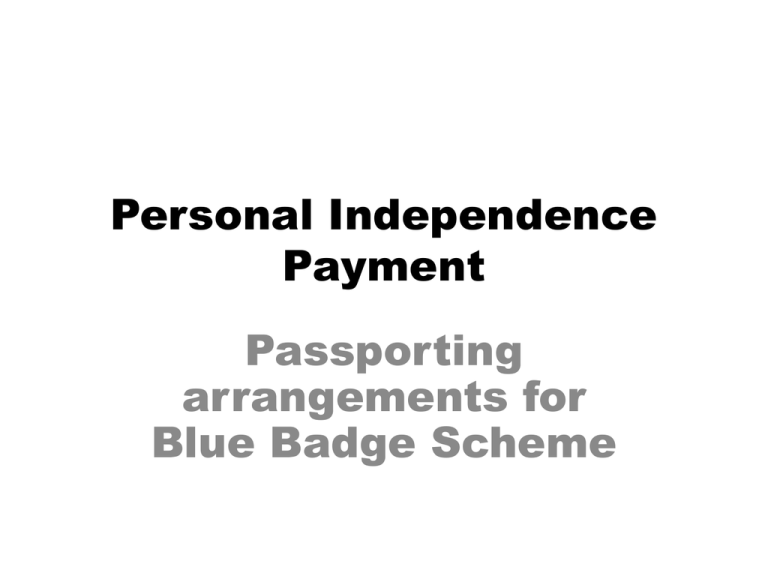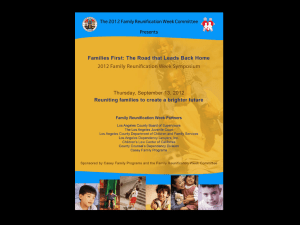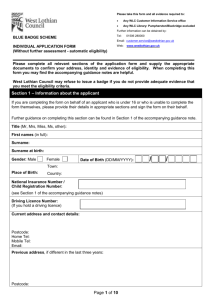Open
advertisement

Personal Independence Payment Passporting arrangements for Blue Badge Scheme Blue Badge Scheme Objectives Introduce Regulations (from 8 April 2013) which provide passport from Personal Independence Payment to the Blue Badge Scheme To maintain wherever possible, equivalence between the arrangements for Higher Rate Mobility Component of DLA. Blue Badge Scheme – Criteria Passporting arrangements will apply to those people who receive the Mobility Component of PIP: awarded at 12 points (enhanced rate) for "planning and following journeys" which includes those who cannot follow the route of a familiar journey without another person, assistance dog, or orientation aid. OR those persons who receive the Mobility Component of PIP for "moving around" at 8 points (standard rate) or more. Transitional Arrangements Allow those who are in receipt of HRMCDLA and subsequently not awarded PIP, to retain their badge until its expiry date. Determining Blue Badge eligibility using Personal Independence Payment (PIP) award notifications Mobility Activities Points 1. Planning and following journeys A I’ve decided you can plan and follow a route of a journey unaided. B I’ve decided you need prompting from another person to undertake a journey to avoid causing you significant mental distress. 0 C I’ve decided you can’t plan the route of a journey. 8 D I’ve decided you need another person, an assistance dog or an orientation aid to follow the route of an unfamiliar journey. 10 E I’ve decided you can’t undertake any journey because it would cause you significant mental distress. 10 4 Eligible Not eligible F I’ve decided you can’t follow the route of a familiar journey 12 without another person, an assistance dog or an orientation aid. Determining Blue Badge eligibility using Personal Independence Payment (PIP) award notifications (continued) Points 0 B I’ve decided you can stand and then move more than 50 metres but no more than 200 metres. C I’ve decided you can stand and then move unaided more than 8 20 metres but no more than 50 metres. D I’ve decided you can stand and then move using an aid or appliance more than 20 metres but no more than 50 metres. E I’ve decided you can stand and then move more than 1 metre 12 but no more than 20 metres. F I’ve decided you cannot stand or move more than 1 metre. 4 Not eligible 10 12 Eligible A Mobility Activities 2. Moving around I’ve decided you can stand and then move more than 200 metres. Blue Badge Scheme –Impact 100,000 currently on HRMCDLA in Scotland will be reassessed for PIP. 60% (60,000) in receipt of HRMCDLA take up entitlement to a Blue Badge. Of those: 43% may have an unchanged or increased award from DWP and retain passport to Blue Badge. 29% may receive a decreased award. 27% may not receive a PIP award Blue Badge Scheme Where there is no entitlement to PIP: • people can apply to local authorities through the Blue Badge subject to further assessment eligibility criteria which has similar mobility descriptors to passporting benefits. • those who had previously received a Blue Badge through passporting will be able to retain the Blue Badge until its expiry date. • those who no longer qualify for a Blue Badge at all may be entitled to concessionary fares. National Concessionary Travel Scheme 22 April 2013 National Concessionary Travel Scheme • Scheme has been in place since 2006 • Recently secured through to March 2015 • Successful – over 1.25 million users • 189,000 of these hold cards through disability criteria Benefits of NCTS • Social – people can get out and about • Health – people are often more active • Financial – average value for cardholder is £250 each year • Available for use on buses – Plus – for island residents – 2 return journeys per year to the mainland by ferry Welfare Reform • Disability Living Allowance being phased out • Personal Independence Payments starting April 2013 • Affects people between 16 and 64 • New regulations allow those awarded PIP to be eligible for NCTS Passport to NCTS • DLA-based –Higher rate mobility component –Higher or middle rate care component • PIP-based –Standard or enhanced rate Passport to NCTS DLA Care PIP Mobility Daily Living Mobility Passport to Companion Card • DLA-based –Higher or middle rate care component • PIP-based –Standard or enhanced rate of daily living component Passport to Companion Card DLA Care PIP Mobility Daily Living Mobility Eligibility for NCTS Estimated eligibility (approx) Through PIP Increase (compared with DLA) NCTS 174,000 3,000 Companion Card 133,000 9,000 Application for NCTS • As now, through Local Authorities • Front line staff have information on PIP eligibility • Anyone not receiving PIP may still be able to apply under existing criteria • If no PIP awarded, the card may be used until it expires Alternative criteria Continuing as now ... • Aged 60 or over • Attendance Allowance • Blue Badge • Registered Blind / registered partially sighted • Profoundly or severely deaf • Having lost a limb / limbs • Have been or would be refused a driving licence • Have mental health issues – covers mental illness, learning disability and personality disorder • ... Monitoring Impact • Overall, over 20% fewer people will receive PIP than receive DLA • But slightly more people will be eligible for NCTS through PIP than through DLA • Phasing in June 2013 October 2013 October 2015 New applications Existing DLA claimants when changes reported Reassessment of existing DLA claimants Contact us Any questions freebus@transportscotland.gsi.gov.uk Local Authority staff knowledge hub







